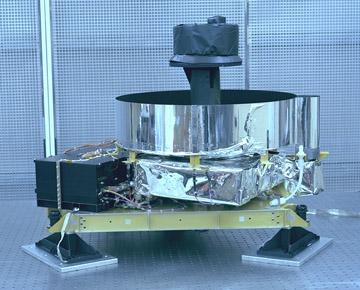

The Mars Global Surveyor spacecraft, launched November 7, 1996 by the National Aeronautics and Space Administration (NASA) and the Jet Propulsion Laboratory (JPL) of the California Institute of Technology, carries a remote-sensing instrument, MOLA-2, a laser altimeter with a range precision of 37 centimeters, and a profiling resolution on the Martian surface of ~300 m. MOLA's vertical accuracy is limited by the orbital determination for the spacecraft, and is currently at the sub-5-m level (~1-meter not including geoid error!) but is expected to improve further with advanced orbit reconstruction techniques.
MOLA-2, aka the Mars Orbiter Laser Altimeter, was designed by the Laser Remote Sensing Branch of the Laboratory for Terrestrial Physics of NASA/GSFC, with support from Goddard's Engineering Systems Analysis Branch. MOLA-2 is a descendant of the MOLA instrument carried aboard the ill-fated Mars Observer spacecraft.
The original MOLA instrument was described in:
Zuber, M.T., et al., The Mars Observer Laser Altimeter Investigation, J.
Geophys. Res., 97, 7781-7797, 1992.
A description of the laser transmitter can be found in:
Afzal, R.S., Mars Observer Laser Altimeter: Laser
transmitter, Applied
Optics, 33, 3184-3188, 1994.
The SLA-01 and SLA-02 instruments built from MOLA spares were flown successfully aboard the Space Shuttle as Hitchhiker experiments.
MOLA is also the type genus of a family of "strange, large oceanic fishes", Molidae, with a millstone-like, tetraodontiform shape.